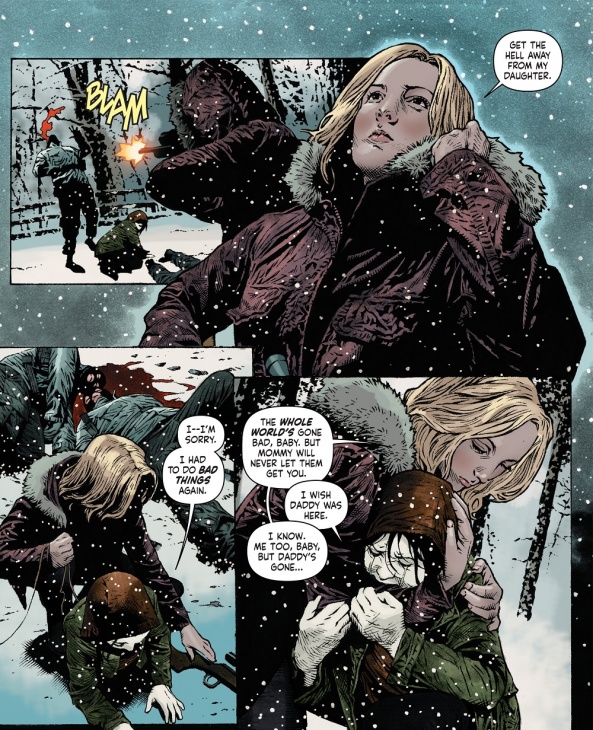There are a lot of comics out there, but some just stand out head and shoulders above the pack. With “Don’t Miss This” we want to spotlight those series we think need to be on your pull list. This week, we look at the continued evolution of Bloodshot as he tries to take Guile’s advice and be a family man.

Who is this by?
“Bloodshot: Salvation” is written by Jeff Lemire with art by Lewis LaRosa and Mico Suayan, color by Diego Rodriguez and Brian Reber, and letters by Simon Bowland
What is it all about?
Like the best Valiant titles there is a high minded yet pulpy sci-fi exterior that wraps around a very human, emotional, center. “Salvation” acts as a continuation of Lemire’s run with the character from the pages of “Bloodshot: Reborn.” While this is a continuation, “Salvation” is a good jumping on point with its own wants and interest. The new series shifts it’s investigation from “can Bloodshot be a force for good?” too “can Ray Garrison be a family man, and still be Bloodshot?” Lemire’s shift in questioning sets up “Salvation” to be a family drama that aims for Parenthood-like good cries but mixing the salt of tears with the coppery taste of blood as violence never seems to far away from this family.

What makes it great?
What makes “Salvation” great and worth reading, is its thematic interest and how those interests are executed. Jeff Lemire is someone who likes to get ahead on projects, and Valiant used that to announce that the first year of the book will be broken into three distinct sections, or books: Revenge, Dead, and Revelations. In the endless waltz of cape comics, it’s nice to have an idea of what the movements are.
But that knowledge means little if it isn’t executed on properly. In the case of “Salvation” the how it goes about telling its story is almost as interesting as the story itself. Currently “Salvation” features two main art teams led by illustrators Lewis LaRosa and Mico Suayan. The need for separate illustrators is due to Lemire writing the series in two separate time periods. There is the present story done by LaRosa and the not too distant future drawn by Mico Suayan. Each artist brings their unique styles to the period LaRosa’s soft figures and the colorist smooth gradation makes you wonder if this is the present or a nostalgic past, as Ray abandons his young family on quest for vengeance against Magic’s father, a mysterious cult leader. LaRosa’s soft art is immediately juxtaposed by the series other half, a Logan-esque future where Suayan’s sharp line work and overall muted color palette tell you immediately something has gone horrible wrong. In both cases these art styles are effective vehicles for melodrama as things turn upside down for this family.
In the both periods, Magic takes care of their young child Jessie. In the present Baby Jessie is starting to take after her Father in very particular ways. While in the not to distant future, Magic and Jessie are on the run from Omen, a mysterious shadow organization set on capturing and controlling the nanites. The shift towards a family drama has allowed Lemire to open up the cast and make Magic a character a functional character. In the prior series she was more an object of desire than a fully formed character due to how the that series handled perspective. In “Salvation,” Magic is given a greater sense of agency as she goes about protecting her daughter.
Bloodshot, while originally a product of the nineties, is very much in the mold of the previous decades hard bodied action hero. Previous series have used these inherent characteristics to play to a Deadpool like body humor, Lemire takes things in a more introspective note by portraying Ray Garrison and Bloodshot as if not separate people, dueling persona trying to maintain control.

After being told not to go hunting her family, Ray is at war with himself. “Every cell in my body tells me not to do it. They scream at me to just trust magic and let it go. But those very same cells are laced with little machines called nanites. And those nanites have never really been good at listening to my conscious. They start going to work and before I know it I’m not in Michigan anymore…” All of this realized in a beautiful pair of mirrored panels that show the ease at which these two halves interact with one another.
Continued belowJeff Lemire has setup a series to also serve as an interrogation of that brand of masculinity, and its foolish outgrowths. As Bloodshot, Ray Garrison is probably second only to Aric of Dacia and his armor or Livewire in terms of raw power. And yet, unlike his contemporaries, he feels the need to constantly display and practice his power to prove himself. LaRosa does an excellent job playing with perspective making Garrison even when he isn’t the pale killer appear monstrous and fill panels. This avenue provides an interest subtext to the familial drama playing out.
With its dueling narratives, and smart planning from Jeff Lemire, on top of excellent art from the art team, “Bloodshot: Salvation” has the right ingredients to make for an engrossing read.
How can you read it?
“Bloodshot: Salvation” is currently being released in single issue physically and digitally with the first trade collecting the first 5 issues of the series sometime in early 2018. With issue 4 being released this week, it’s still early enough to catch up in singles, but with how this book is being setup following it in trade should be just as easy, if a longer wait.






